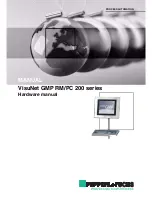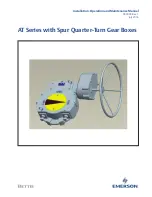
en05c361.fm, 23.04.2009
P1934E/EN 2009-04
99
Statistics
5
2.
Designate the Sample Size
It is usually desirable to keep the sample size small so that variation within the sample is at a
minimum, but not so small that statistical validity is lost. The control chart described in this docu-
ment is structured for a sample size of five units. If a sample other than five is selected, the man-
ufacturing or quality engineer can provide alternate factors for use in calculating the control limits
and standard deviation (Steps 8 and 10).
3.
Designate the Sample Frequency
Selection of the sample frequency should be based on economic considerations for the cost of
measurements and the potential loss that may occur if samples are not taken often enough.
Early in the production run, samples should be taken more frequently and then extended after
satisfactory control is verified. The frequency may be expressed as a time interval or as a portion
of quantities produced.
4.
Assure Measurement Accuracy
Measurement accuracy is mandatory for successful statistical control. Measuring and test equip-
ment must be of a type suitable for the characteristic being evaluated, and must be calibrated
and properly used. Decisions resulting from the analysis of a control chart will be no better than
the measurement data.
5.
Complete the Data Sheet Headings
It is important that all heading entries on the data sheet be completed. They include the part
number and description, the operation performed, the name of the operator, the machine or
equipment used, and the specification limits. The data sheet and control chart can provide evi-
dence of quality for use by the Quality Assurance organization if the information is properly
recorded and traceable to the products manufactured.
6.
Start Production
Take samples of five units (preferably consecutive units produced) at the designated frequency,
and record each measurement (X) on the data sheet. For each sample of five calculate the aver-
age ( ) and range (R), and plot the results on the chart (see Fig. 5-3:).
0
4
8
12
16
20
R
X
- Add the five measurements and divide the sum by five.
For a sample of five, it is often easier to multiply the sum
by two and move the decimal one place to the left.
R - Substract the smallest measurement from the largest.
(Note that the range can never be negative.)
R
ange
A
ver
age
Fig. 5-3: Entries for Range and Average
Содержание LIVEWIRE TMEC-200 Series
Страница 6: ...6 P1934E EN 2009 04 P1934E EN_2009 04_TMEC200_V2 03 08IVZ fm 23 04 2009...
Страница 14: ...14 P1934E EN 2009 04 en01c381 fm 23 04 2009 Getting started 1...
Страница 104: ...104 P1934E EN 2009 04 en05c361 fm 23 04 2009 Statistics 5...
Страница 109: ......
Страница 110: ......












































